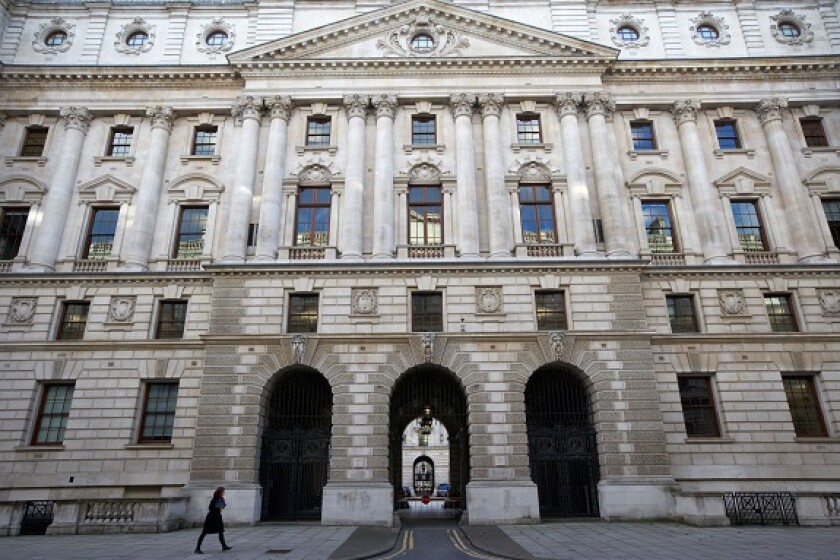The UK launched its second green Gilt to an enthusiastic reception on Thursday, having delayed it by two days so investors could digest the government’s Net Zero Strategy. Bond investors lapped up the deal, apparently approving the UK’s plans for cutting emissions, but analysts fear the Strategy is long on talk, short on financial backing.
Gilt issues usually come on Tuesdays, but after the murder of Sir David Amess MP on Friday the government held back its major green policy announcements from Monday to Tuesday. The Debt Management Office and its bookrunners therefore judged it better to give investors more time to examine the Strategy.
That looked a prudent choice — the transaction achieved everything that could have been hoped for in the primary bond market.
In the court of expert opinion, however, the Net Zero Strategy has received mixed reviews. It includes support for ‘blue’ hydrogen; carbon capture, use and storage (CCUS); and greenhouse gas removal technologies, all of which greens regard as unproven and risky ideas, compared with reducing emissions through renewable power and energy efficiency.
Technology doubts
Some of these frontier technologies were discussion points when the first green Gilt was launched, prompting Triodos, the sustainable bank and investment firm, not to participate.
NN Investment Partners gave the first bond a “benefit of the doubt green label”, thanks to the UK’s assurance that CCUS and blue hydrogen projects would absorb less than 10% of the proceeds.
However, NN did voice its concerns to the DMO “around over-reliance on these technologies”, according to Isobel Edwards, a green bonds investment analyst at the asset manager.
Although the UK’s Green Financing Framework sets out what kinds of projects are eligible for financing with green Gilts, investors have not yet been told comprehensively what sums of money have in fact been allocated to which projects.
The Net Zero Strategy announcement gives new information on additional government funding for types of projects that may be financed by green Gilts, according to the DMO.
It supplies more detail on several areas of environmental policy on which the UK’s strategy and Green Financing Framework had not previously been clear.
For example, it promises demonstrations and trials of “clean maritime vessels and infrastructure”, but does not go into more depth. Edwards observed that shipping was “hard to decarbonise”.
Biofuel questions
The Strategy promises to accelerate tree planting to sequester carbon. However, while this is a worthy aim, there are risks that new forests could be sold to industries to offset carbon emissions that they are not reducing fast enough.
The Strategy outlines a promise to “enable delivery of 10% Sustainable Aviation Fuel by 2030”, making £180m available to support the development of this nascent technology.
On Wednesday, Rolls-Royce completed a four hour test flight of a Boeing 747 in which one of its four engines was powered entirely with SAF.
However, Edwards was concerned that the SAF target did not include “a clear idea of where the feedstock for the SAF is going to come from”. She said this was crucial to assessing the environmental impact of SAF.
SAF, like all fuels made from plants, is a hydrocarbon and causes CO2 emissions when burnt. They can contribute to reducing overall emissions only if the plant growth is additional to what existed before the land was turned over to biofuel cultivation, and if the plants sequester carbon as fast as the fuels are burnt.
Edwards said more details on these categories of spending would “give us a better idea of the bond’s eligibility for a green label by our standards, if the DMO plans to significantly include them in the use of proceeds of the second green Gilt”.
Rampant demand
While some sophisticated green bond investors have qualms, the market as a whole flocked to the deal.
The order book for the £6bn no-grow 2053 bond swelled to £74bn, giving it a subscription ratio of 12.3 — the highest ever recorded for a public sector green bond.
The £6bn bond was priced at 102.214, meaning the DMO will receive £6.13bn. That takes the total value of green Gilts to £16.1bn — above the £15bn the Treasury had aimed for this year.
The lead managers — Bank of America, Morgan Stanley, NatWest Markets, RBC Capital Markets and Santander — opened books with guidance of flat to 1bp through the 3.75% July 2052 Gilt.
After just half an hour of bookbuilding, the order book was over £48bn, including £5.6bn of orders from the leads. The guidance was revised to 0.5bp-1bp through the benchmark.
With the order book at £59bn, the spread was fixed at minus 1bp, which the leads said implied a greenium of 2.5bp.
An investor agreed with the assessment: “I saw fair value flat to the 2052 benchmark, and we normally expect to see 1bp-1.5bp new issue concession, so 2.5bp greenium sounds right to me.”
A 2.5bp greenium equates to an annual saving of £1.5m compared with conventional debt.
The book kept growing at this pricing, closing with more than £74bn of orders, including the same £5.6bn from the leads.
The investor said that, as with the first green Gilt, his firm had received low allocations because of the huge book.
“Investors appreciated the opportunity to process the strategy,” said a banker on the deal. “The Treasury has done a great job in reaching out to investors to answer all their questions and make sure they were comfortable with the details. That really helped with making the execution a smooth process.”
One and a half cheers
Environmental analysts have been at once impressed and exasperated with the UK’s Strategy.
“It’s probably the most comprehensive national net zero strategy that has been set out anywhere in the world,” said Ed Matthew, campaigns director at E3G, the climate change think tank in London. “It’s arguably world-leading. Ahead of COP26, they had to do it — it would have been nice if they had done it earlier — but it’s got impressive targets and a sectoral breakdown.”
Prime minister Boris Johnson and business secretary Kwasi Kwarteng won praise for casting the low carbon transition clearly as a growth opportunity that would spur investment and jobs and contribute to the UK’s ‘levelling up’ agenda of raising living standards in poorer regions.
They unequivocally stated that the recent surges in gas prices, which some have blamed on green policies, were instead a reason to accelerate the transition to renewable energy and away from unreliable, volatile foreign fossil fuel supplies.
However, although the rhetoric is inspiring, on close examination the policies are patchy.
The Strategy describes measures the government will adopt to put the economy on track for net zero emissions in 2050, and a 68% reduction from 1990 levels by 2030.
According to its own calculations, the UK has already cut emissions by 44% since 1990.
The plan envisages a rise in emissions this year as the economy restarts after Covid shutdowns, bringing emissions to about 460m tonnes of CO2 equivalent a year, then a slight decline to 2024, followed by an acceleration in 2025, to reach about 190m tonnes in 2037.
Faith in nuclear
Electricity will be fully decarbonised by 2035, though there is a get-out for “security of supply”.
To achieve that, offshore wind will be quadrupled and there will be more onshore wind and solar power. But greens are dismayed to see the government expanding the role of nuclear power. It wants to reach a final investment decision on a new large nuclear power station by the end of this Parliament in 2024 and to encourage small ‘modular’ nuclear reactors.
Meanwhile, there is very little mention of rooftop solar power.
The government will promote hydrogen as an alternative fuel for industries that are hard to electrify, such as steel and cement, and explore its potential for domestic use, starting with an experimental ‘hydrogen village’.
It will work with industry to decarbonise, including through local ‘clusters’ that will trial CCUS. There was heavy emphasis on greenhouse gas removal, with the aim of being able to sequester 5m tonnes of CO2 a year by 2030.
But oddly, land use — including agriculture, a major contributor to emissions — was bundled together with waste management and fluorinated gases.
Pinching pennies
Ironically in the week when the Treasury showed again how readily it can raise funding for green investments, the big shock for observers in the UK Strategy was how little money it is putting behind it.
“There isn’t the funding in place,” said Matthew. “If they want to redirect the economy at the greatest speed possible, the level of commitment on investment is not there to get on track for the UK’s carbon budgets.”
E3G and Cambridge Macroeconomics had estimated that the UK government needed to invest an extra £16bn in 2022-25, the period covered by the Comprehensive Spending Review due out next week.
They calculate that the Net Zero Strategy includes only £6bn of that.
“The biggest gap is in buildings,” said Matthew, “which seems incredible. All analysis has made it clear that this kind of capital investment is great for growth and jobs. It’s a colossal infrastructure challenge, with 30m buildings in the UK that need heating and energy efficiency upgrades. So why are they tightening their belts, at a moment of environmental and economic peril for the country?”
Compared with manifesto commitments, the government was £9bn short on what it should be investing in energy efficiency, Matthew said.
The DMO said no decisions had been taken yet on future green funding transactions.





